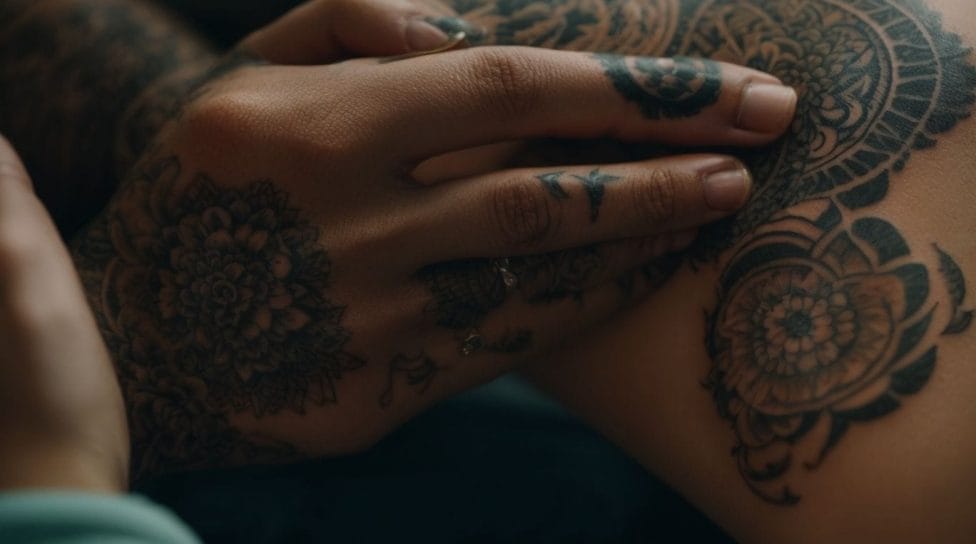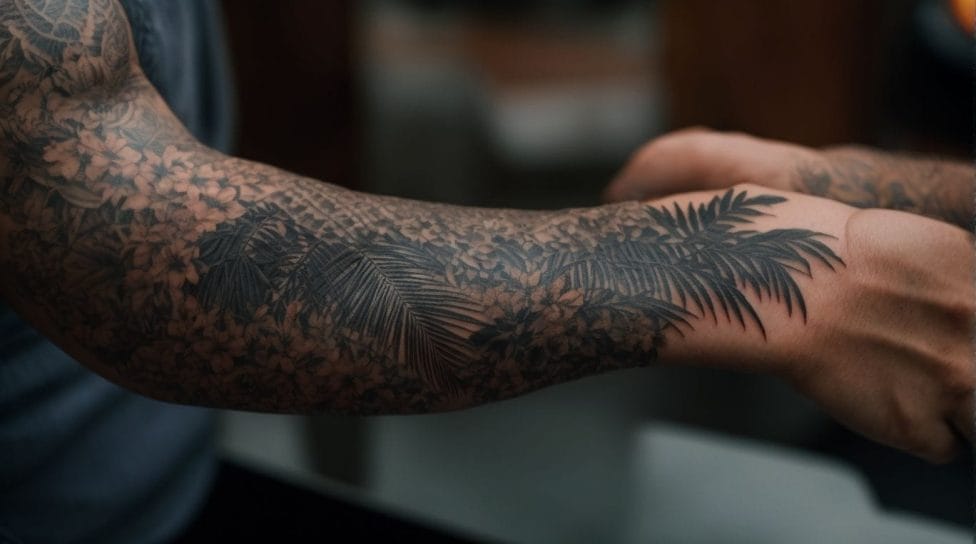Getting a tattoo is a unique and personal experience that can be exciting yet nerve-wracking for many. One of the common questions that arise is how tattoos feel. The sensation and pain experienced during the tattooing process can vary from person to person and depends on several factors.
Factors Affecting Tattoo Pain:
Various factors can influence the level of pain experienced during a tattoo session. These factors include the individual’s pain tolerance, the location of the tattoo, the size and complexity of the design, and the skill and technique of the tattoo artist. Factors like fatigue, stress levels, and hormonal changes can also impact how a tattoo feels.
What Does Getting a Tattoo Feel Like?
1. Initial Discomfort: When the needle touches the skin, you may experience some discomfort, similar to a sharp scratch. This sensation is often fleeting.
2. Pricking Sensation: As the tattoo artist continues to work on your skin, you may feel a constant pricking sensation. This can vary in intensity depending on the individual and the tattooed area.
3. Deep Pressure and Vibration: Deeper layers of the skin may elicit feelings of pressure and vibration as the tattoo machine penetrates further. The intensity of these sensations can also vary.
4. Hot and Cold Sensations: Some individuals may experience occasional hot or cold sensations during the tattooing process. These sensations are often fleeting and can be attributed to the body’s reaction to the tattooing process.
Areas of the Body with Higher Sensitivity:
Certain body areas are known to be more sensitive than others, and tattooing these areas may cause more discomfort. These include bony areas, thin skin, and highly innervated areas like the wrists, ankles, ribs, and spine.
Tips to Manage Tattoo Pain:
While everyone’s pain tolerance is different, there are some tips to help manage tattoo pain and make the experience more comfortable:
1. Choose the Right Placement: Consider getting your tattoo in an area with thicker skin or more fat to help minimize discomfort.
2. Stay Hydrated: Drink plenty of water before your tattoo session to ensure your body is adequately hydrated, which can help with pain management.
3. Mindful Breathing Techniques: Practice deep breathing techniques to help relax your body and divert your attention away from the pain.
4. Numbing Creams and Painkillers: Discuss with your tattoo artist or a healthcare professional if using numbing creams or taking over-the-counter painkillers is appropriate for you.
Remember, the pain experienced during a tattoo session is temporary, and for many, the result is well worth it. It’s essential to communicate openly with your tattoo artist about any concerns or discomfort you may have throughout the process.
Key takeaways:
- Tattoo pain varies: The sensation of getting a tattoo can range from discomfort to a pricking sensation, deep pressure, vibration, and even hot and cold sensations.
- Sensitivity by body areas: Bony areas, areas with thin skin, and highly innervated areas tend to be more sensitive when getting a tattoo.
- Pain management tips: Choosing the right placement, staying hydrated, using mindful breathing techniques, and considering numbing creams or painkillers can help manage tattoo pain.
How Do Tattoos Feel?

Photo Credits: Tattooineplanet.Com by Alexander King
Curious about how tattoos feel? Let’s dive right into the nitty-gritty of tattoo pain! We’ll explore the various factors that can influence discomfort during the tattooing process. Get ready to unearth some surprising facts and uncover the secrets behind the sensations accompanying this timeless form of body art. Brace yourself, my friend, because we’re about to embark on a journey into the realm of tattoo sensations!
Factors Affecting Tattoo Pain
- Several factors can affect the level of pain experienced during a tattoo session. These include:
- Placement: Areas with more bones or thin skin tend to be more sensitive and painful.
- Size and Complexity: Larger, more detailed tattoos may take longer to complete, leading to increased discomfort.
- Individual Pain Tolerance: Everyone’s pain tolerance is different, so what might be painful for one person may not be as painful for another.
- Artist Skill and Technique: Experienced tattoo artists know how to minimize pain using proper techniques and tools.
- Mental and Emotional State: Anxiety and stress can amplify the perception of pain, while relaxation techniques can help manage it.
To help manage tattoo pain, some suggestions include staying well-hydrated, practicing deep breathing techniques, using numbing creams or painkillers (if approved by the tattoo artist), and choosing a suitable placement for the tattoo. Remember, pain levels can vary, so it’s important to communicate with your tattoo artist and care for yourself during the tattoo process.
What Does Getting a Tattoo Feel Like?

Photo Credits: Tattooineplanet.Com by Jack Ramirez
Curious about the tattooing experience? Brace yourself for a rollercoaster of sensations! From the initial discomfort to the mesmerizing pricking sensation, along with deep pressure, vibration, and even bursts of hot and cold sensations, getting a tattoo is no ordinary experience. Get ready to delve into the world of ink and discover what lies beneath the surface as we explore the varied sensations one encounters throughout the tattooing process.
Initial Discomfort
The initial discomfort experienced during the tattooing process is a common aspect that individuals should be aware of. While pain tolerance varies among individuals, it is important to understand that initial discomfort is expected during the tattooing process due to the sensation caused by the tattoo needle penetrating the skin. This initial discomfort can be likened to a pricking or stinging sensation. It is essential to note that the level of discomfort largely depends on factors such as the individual’s pain threshold, the location of the tattoo on the body, and the skill of the tattoo artist.
Pricking Sensation
The pricking sensation, often described as a feeling of tiny pinpricks or bee stings, is a common occurrence during the tattooing process. When the tattoo needle punctures the skin, it can generate a sharp and stinging sensation. The intensity of this pricking sensation may vary depending on factors such as the tattoo’s location, the individual’s pain tolerance, and the tattoo artist’s skill. To help manage the discomfort, some individuals choose to use numbing creams or painkillers. It is crucial to communicate with your tattoo artist and take breaks if necessary to ensure a more comfortable experience.
Deep Pressure and Vibration
When getting a tattoo, individuals can experience deep pressure and vibration. These sensations occur naturally as the tattoo machine penetrates the skin layers and deposits ink into the dermis.
- Deep pressure: As the tattoo needle punctures the skin, it generates a profound pressure sensation. This can be perceived as a pressing or pushing feeling on the skin.
- Vibration: The tattoo machine also produces a vibrating sensation as it moves back and forth. This vibration is felt throughout the surrounding skin and tissues.
The combination of deep pressure and vibration contributes to the unique sensation of getting a tattoo. Although different individuals may perceive these sensations differently, they are a common and integral part of the tattooing process.
Hot and Cold Sensations
Hot and cold sensations are common experiences during the tattooing process. As the tattoo needle penetrates the skin, it can elicit a range of sensations, including a hot or burning feeling. This sensation is caused by the friction and heat generated from the needle’s movement. Conversely, some people report feeling a cold sensation during tattooing, which can be attributed to the cooling effect of the ink and the evaporation of bodily fluids. These hot and cold sensations are part of the process and vary depending on individual pain tolerance and the location of the tattoo on the body.
True story:
I remember getting my first tattoo on my forearm. As the artist worked, I felt hot and cold sensations. The needle piercing my skin caused a burning heat, making me break out in a slight sweat. Yet, there were also moments when the ink felt refreshingly cool, providing relief. It was fascinating how these contrasting sensations danced on my arm during the tattooing process, creating a unique experience I’ll always remember.
Areas of the Body with Higher Sensitivity

Photo Credits: Tattooineplanet.Com by Joshua Garcia
If you’ve ever wondered what getting a tattoo feels like, you’re in the right place. We’re about to explore the various areas of the body and their levels of sensitivity during the tattooing process. From bony areas to spots with thin skin and highly innervated regions, each sub-section will shed light on the unique sensations experienced when ink meets skin. Get ready to uncover the fascinating world of tattoo pain and sensation!
Bony Areas
| The tattooing process can be more painful in bony areas of the body because there is less muscle or padding to cushion the sensation. | |
| The following table showcases these bony areas and their corresponding sensitivity levels: | |
| Area | Sensitivity Level |
| Ribs | High |
| Spine | High |
| Sternum | High |
| Collarbone | Medium |
| Shins | Medium |
| Knees | Medium |
Areas with Thin Skin
- Areas with thin skin, such as the inner wrist, inner arm, armpit, fingers, behind the ear, neck, inner thigh, behind the knee, and ankle, are more sensitive to tattoo pain.
- When getting a tattoo in these areas, the pain may feel sharper and more intense.
- To manage the discomfort, it’s important to communicate with your tattoo artist and take breaks if needed.
- Applying numbing cream beforehand can also help alleviate some of the pain.
Highly Innervated Areas
Highly innervated areas, such as the ribs, groin, armpits, and the inside of the elbows and knees, are regions of the body where the nerves are densely packed. This dense packing of nerves in these areas increases sensitivity during the tattooing process, resulting in more discomfort and pain compared to other parts of the body.
It is important to keep in mind that pain tolerance varies from person to person. What may be highly innervated and sensitive for one individual may not be as uncomfortable for another.
Tattoo artists aware of these highly innervated areas may suggest different techniques or pain management options to minimize discomfort during the tattooing process.
Tips to Manage Tattoo Pain

Photo Credits: Tattooineplanet.Com by Christopher Moore
Are you looking to get inked? Discover effective tips to manage tattoo pain and make your experience more comfortable. From choosing the right placement to exploring mindful breathing techniques, we’ve got you covered. Stay hydrated, consider numbing creams, and learn about painkillers that can ease the process. With these practical strategies, you can approach getting a tattoo with confidence and minimize any discomfort. So, let’s dive in and uncover the secrets to managing tattoo pain like a pro!
Choose the Right Placement
When getting a tattoo, it is essential to select the appropriate placement carefully. Ensuring a positive experience and achieving optimal results are factors to consider. One must take into account visibility and personal preferences while making this decision. It is crucial to note that choosing a placement on highly visible areas, such as the forearm or neck, can potentially impact professional opportunities. Additionally, individuals should factor in their pain tolerance and sensitivity levels. Areas with more flesh or muscle, such as the upper arm or thigh, typically result in less pain.
Moreover, individuals should also consider the design itself. Designs with a flowing nature, like vines, are best suited for curved areas like the upper back or shoulder. By choosing the right placement, individuals can enhance the overall aesthetic and meaning of their tattoo.
Stay Hydrated
Staying hydrated is crucial in managing tattoo pain and promoting the healing process. To stay hydrated, learn more about how tattoos feel.
- Ensure you drink plenty of water throughout the day to maintain proper hydration.
- Avoid the consumption of alcohol and caffeine, as they can dehydrate your body.
- Incorporate hydrating foods, such as fruits and vegetables, into your diet.
- Nourish your skin using moisturizing lotions or creams to keep it hydrated from the outside.
- To expedite the healing process, minimize sun exposure, which can dehydrate your skin.
In ancient civilizations, staying hydrated was paramount during tattooing to prevent infections and alleviate pain. Tattoo artists often offered their clients water or herbal drinks to ensure they remained hydrated and comfortable during the tattooing process.
Mindful Breathing Techniques
Mindful Breathing Techniques can be utilized to effectively manage tattoo pain and promote a tranquil state of mind throughout the entire process. Here are some simple steps to seamlessly incorporate mindful breathing during a tattoo session:
- First, find a cozy and comfortable position that allows your body to relax completely.
- Next, take slow and deep breaths through your nose, ensuring your lungs are filled to their maximum capacity.
- Pause at the top of your inhalation before slowly exhaling through your mouth, releasing any built-up tension in your body.
- Direct your attention to the sensation of your breath entering and leaving your body, focusing solely on this process.
- Allow the rhythm of your breath to guide you, using it as an anchoring force to keep your mind centered and grounded.
- If you experience any pain or discomfort during the tattooing process, consciously redirect your breath towards those specific areas, envisioning a soothing effect on the sensation.
- Continue practicing this mindful breathing technique throughout the entire tattoo session, utilizing it as a valuable tool to remain fully present and effectively manage any sensations that arise.
By consistently practicing mindful breathing, you can cultivate a deep sense of relaxation and significantly reduce any discomfort encountered during the tattooing process. Additionally, it is crucial to maintain open communication with your tattoo artist and take necessary breaks as needed.
Numbing Creams and Painkillers
Using numbing creams and painkillers can effectively manage the pain and discomfort associated with the tattooing process. Here are some options to consider:
- Numbing creams: These topical creams are formulated with ingredients such as lidocaine or benzocaine, which help numb the skin and minimize the pain during tattooing.
- Painkillers: Taking over-the-counter pain relievers like ibuprofen or acetaminophen before your tattoo session can aid in reducing both pain and inflammation.
- Consult your tattoo artist: It is essential to discuss with your tattoo artist before using any numbing creams or painkillers to ensure that it does not interfere with the tattooing process or the outcome.
- Follow instructions: Always adhere to the instructions provided with the numbing cream or painkiller, and if you have any concerns or medical conditions, it is recommended to consult with a healthcare professional.
Some Facts About How Do Tattoos Feel:
- ✅ Getting a tattoo can be nerve-wracking, especially for first-timers. (Source: popsugar.com)
- ✅ The sensation of getting a tattoo is often described as a scratching or stinging feeling. (Source: popsugar.com)
- ✅ The pain level of a tattoo varies depending on the individual’s pain tolerance and the location of the tattoo. (Source: popsugar.com)
- ✅ Fine-line tattoos with a single needle are less painful than traditional tattoos with multiple needles. (Source: popsugar.com)
- ✅ The least painful areas for tattoos are usually on fleshier body parts, such as the wrist or forearm. (Source: cosmopolitan.com)


